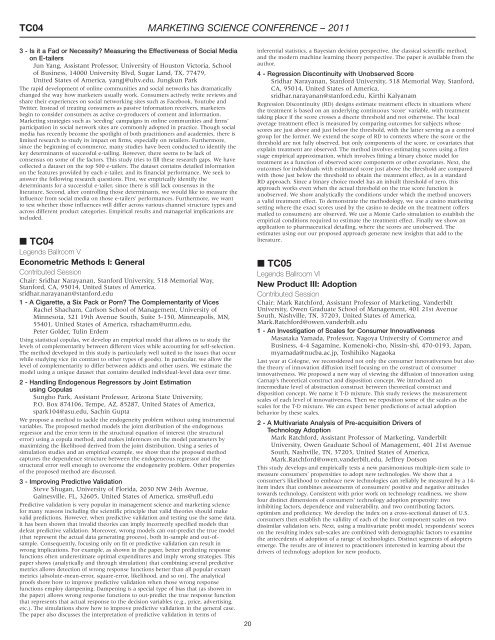Conference Sessions - Jesse H. Jones Graduate School of ...
Conference Sessions - Jesse H. Jones Graduate School of ...
Conference Sessions - Jesse H. Jones Graduate School of ...
You also want an ePaper? Increase the reach of your titles
YUMPU automatically turns print PDFs into web optimized ePapers that Google loves.
TC04<br />
3 - Is it a Fad or Necessity? Measuring the Effectiveness <strong>of</strong> Social Media<br />
on E-tailers<br />
Jun Yang, Assistant Pr<strong>of</strong>essor, University <strong>of</strong> Houston Victoria, <strong>School</strong><br />
<strong>of</strong> Business, 14000 University Blvd, Sugar Land, TX, 77479,<br />
United States <strong>of</strong> America, yangj@uhv.edu, Jungkun Park<br />
The rapid development <strong>of</strong> online communities and social networks has dramatically<br />
changed the way how marketers usually work. Consumers actively write reviews and<br />
share their experiences on social networking sites such as Facebook, Youtube and<br />
Twitter. Instead <strong>of</strong> treating consumers as passive information receivers, marketers<br />
begin to consider consumers as active co-producers <strong>of</strong> content and information.<br />
Marketing strategies such as ‘seeding’ campaigns in online communities and firms’<br />
participation in social network sites are commonly adopted in practice. Though social<br />
media has recently become the spotlight <strong>of</strong> both practitioners and academies, there is<br />
limited research to study its impact on firms, especially on retailers. Furthermore,<br />
since the beginning <strong>of</strong> ecommerce, many studies have been conducted to identify the<br />
key determinants <strong>of</strong> successful e-tailing. However, there seems to be lack <strong>of</strong><br />
consensus on some <strong>of</strong> the factors. This study tries to fill these research gaps. We have<br />
collected a dataset on the top 500 e-tailers. The dataset contains detailed information<br />
on the features provided by each e-tailer, and its financial performance. We seek to<br />
answer the following research questions. First, we empirically identify the<br />
determinants for a successful e-tailer, since there is still lack consensus in the<br />
literature. Second, after controlling those determinants, we would like to measure the<br />
influence from social media on those e-tailers’ performances. Furthermore, we want<br />
to test whether those influences will differ across various channel structure types and<br />
across different product categories. Empirical results and managerial implications are<br />
included.<br />
■ TC04<br />
Legends Ballroom V<br />
Econometric Methods I: General<br />
Contributed Session<br />
Chair: Sridhar Narayanan, Stanford University, 518 Memorial Way,<br />
Stanford, CA, 95014, United States <strong>of</strong> America,<br />
sridhar.narayanan@stanford.edu<br />
1 - A Cigarette, a Six Pack or Porn? The Complementarity <strong>of</strong> Vices<br />
Rachel Shacham, Carlson <strong>School</strong> <strong>of</strong> Management, University <strong>of</strong><br />
Minnesota, 321 19th Avenue South, Suite 3-150, Minneapolis, MN,<br />
55401, United States <strong>of</strong> America, rshacham@umn.edu,<br />
Peter Golder, Tulin Erdem<br />
Using statistical copulas, we develop an empirical model that allows us to study the<br />
levels <strong>of</strong> complementarity between different vices while accounting for self-selection.<br />
The method developed in this study is particularly well suited to the issues that occur<br />
while studying vice (in contrast to other types <strong>of</strong> goods). In particular, we allow the<br />
level <strong>of</strong> complementarity to differ between addicts and other users. We estimate the<br />
model using a unique dataset that contains detailed individual-level data over time.<br />
2 - Handling Endogenous Regressors by Joint Estimation<br />
using Copulas<br />
Sungho Park, Assistant Pr<strong>of</strong>essor, Arizona State University,<br />
P.O. Box 874106, Tempe, AZ, 85287, United States <strong>of</strong> America,<br />
spark104@asu.edu, Sachin Gupta<br />
We propose a method to tackle the endogeneity problem without using instrumental<br />
variables. The proposed method models the joint distribution <strong>of</strong> the endogenous<br />
regressor and the error term in the structural equation <strong>of</strong> interest (the structural<br />
error) using a copula method, and makes inferences on the model parameters by<br />
maximizing the likelihood derived from the joint distribution. Using a series <strong>of</strong><br />
simulation studies and an empirical example, we show that the proposed method<br />
captures the dependence structure between the endogeneous regressor and the<br />
structural error well enough to overcome the endogeneity problem. Other properties<br />
<strong>of</strong> the proposed method are discussed.<br />
3 - Improving Predictive Validation<br />
Steve Shugan, University <strong>of</strong> Florida, 2030 NW 24th Avenue,<br />
Gainesville, FL, 32605, United States <strong>of</strong> America, sms@ufl.edu<br />
Predictive validation is very popular in management science and marketing science<br />
for many reasons including the scientific principle that valid theories should make<br />
valid predictions. However, when predictive validation and testing use the same data,<br />
it has been shown that invalid theories can imply incorrectly specified models that<br />
defeat predictive validation. Moreover, wrong models can out-predict the true model<br />
(that represent the actual data generating process), both in-sample and out-<strong>of</strong>sample.<br />
Consequently, focusing only on fit or predictive validation can result in<br />
wrong implications. For example, as shown in the paper, better predicting response<br />
functions <strong>of</strong>ten underestimate optimal expenditures and imply wrong strategies. This<br />
paper shows (analytically and through simulation) that combining several predictive<br />
metrics allows detection <strong>of</strong> wrong response functions better than all popular extant<br />
metrics (absolute-mean-error, square-error, likelihood, and so on). The analytical<br />
pro<strong>of</strong>s show how to improve predictive validation when those wrong response<br />
functions employ dampening. Dampening is a special type <strong>of</strong> bias that (as shown in<br />
the paper) allows wrong response functions to out-predict the true response function<br />
that represents that actual response to the decision variables (e.g., price, advertising,<br />
etc.). The simulations show how to improve predictive validation in the general case.<br />
The paper also discusses the interpretation <strong>of</strong> predictive validation in terms <strong>of</strong><br />
MARKETING SCIENCE CONFERENCE – 2011<br />
20<br />
inferential statistics, a Bayesian decision perspective, the classical scientific method,<br />
and the modern machine learning theory perspective. The paper is available from the<br />
author.<br />
4 - Regression Discontinuity with Unobserved Score<br />
Sridhar Narayanan, Stanford University, 518 Memorial Way, Stanford,<br />
CA, 95014, United States <strong>of</strong> America,<br />
sridhar.narayanan@stanford.edu, Kirthi Kalyanam<br />
Regression Discontinuity (RD) designs estimate treatment effects in situations where<br />
the treatment is based on an underlying continuous ‘score’ variable, with treatment<br />
taking place if the score crosses a discete threshold and not otherwise. The local<br />
average treatment effect is measured by comparing outcomes for subjects whose<br />
scores are just above and just below the threshold, with the latter serving as a control<br />
group for the former. We extend the scope <strong>of</strong> RD to contexts where the score or the<br />
threshold are not fully observed, but only components <strong>of</strong> the score, or covariates that<br />
explain treatment are observed. The method involves estimating scores using a first<br />
stage empirical approximation, which involves fitting a binary choice model for<br />
treatment as a function <strong>of</strong> observed score components or other covariates. Next, the<br />
outcomes for individuals with estimated score just above the threshold are compared<br />
with those just below the threshold to obtain the treatment effect, as in a standard<br />
RD approach. Since a binary choice model has an inbuilt threshold <strong>of</strong> zero, this<br />
approach works even when the actual threshold on the true score function is<br />
unobserved. We show analytically the conditions under which the method uncovers<br />
a valid treatment effect. To demonstrate the methodology, we use a casino marketing<br />
setting where the exact scores used by the casino to decide on the treatment (<strong>of</strong>fers<br />
mailed to consumers) are observed. We use a Monte Carlo simulation to establish the<br />
empirical conditions required to estimate the treatment effect. Finally we show an<br />
application to pharmaceutical detailing, where the scores are unobserved. The<br />
estimates using our our proposed approach generate new insights that add to the<br />
literature.<br />
■ TC05<br />
Legends Ballroom VI<br />
New Product III: Adoption<br />
Contributed Session<br />
Chair: Mark Ratchford, Assistant Pr<strong>of</strong>essor <strong>of</strong> Marketing, Vanderbilt<br />
University, Owen <strong>Graduate</strong> <strong>School</strong> <strong>of</strong> Management, 401 21st Avenue<br />
South, Nashville, TN, 37203, United States <strong>of</strong> America,<br />
Mark.Ratchford@owen.vanderbilt.edu<br />
1 - An Investigation <strong>of</strong> Scales for Consumer Innovativeness<br />
Masataka Yamada, Pr<strong>of</strong>essor, Nagoya University <strong>of</strong> Commerce and<br />
Business, 4-4 Sagamine, Komenoki-cho, Nissin-shi, 470-0193, Japan,<br />
myamada@nucba.ac.jp, Toshihiko Nagaoka<br />
Last year at Cologne, we reconsidered not only the consumer innovativeness but also<br />
the theory <strong>of</strong> innovation diffusion itself focusing on the construct <strong>of</strong> consumer<br />
innovativeness. We proposed a new way <strong>of</strong> viewing the diffusion <strong>of</strong> innovation using<br />
Carnap’s theoretical construct and disposition concept. We introduced an<br />
intermediate level <strong>of</strong> abstraction construct between theoretical construct and<br />
disposition concept. We name it T-D mixture. This study reviews the measurement<br />
scales <strong>of</strong> each level <strong>of</strong> innovativeness. Then we reposition some <strong>of</strong> the scales as the<br />
scales for the T-D mixture. We can expect better predictions <strong>of</strong> actual adoption<br />
behavior by these scales.<br />
2 - A Multivariate Analysis <strong>of</strong> Pre-acquisition Drivers <strong>of</strong><br />
Technology Adoption<br />
Mark Ratchford, Assistant Pr<strong>of</strong>essor <strong>of</strong> Marketing, Vanderbilt<br />
University, Owen <strong>Graduate</strong> <strong>School</strong> <strong>of</strong> Management, 401 21st Avenue<br />
South, Nashville, TN, 37203, United States <strong>of</strong> America,<br />
Mark.Ratchford@owen.vanderbilt.edu, Jeffrey Dotson<br />
This study develops and empirically tests a new parsimonious multiple-item scale to<br />
measure consumers’ propensities to adopt new technologies. We show that a<br />
consumer’s likelihood to embrace new technologies can reliably be measured by a 14item<br />
index that combines assessments <strong>of</strong> consumers’ positive and negative attitudes<br />
towards technology. Consistent with prior work on technology readiness, we show<br />
four distinct dimensions <strong>of</strong> consumers’ technology adoption propensity: two<br />
inhibiting factors, dependence and vulnerability, and two contributing factors,<br />
optimism and pr<strong>of</strong>iciency. We develop the index on a cross-sectional dataset <strong>of</strong> U.S.<br />
consumers then establish the validity <strong>of</strong> each <strong>of</strong> the four component scales on two<br />
dissimilar validation sets. Next, using a multivariate probit model, respondents’ scores<br />
on the resulting index sub-scales are combined with demographic factors to examine<br />
the antecedents <strong>of</strong> adoption <strong>of</strong> a range <strong>of</strong> technologies. Distinct segments <strong>of</strong> adopters<br />
emerge. The results are <strong>of</strong> interest to practitioners interested in learning about the<br />
drivers <strong>of</strong> technology adoption for new products.

















